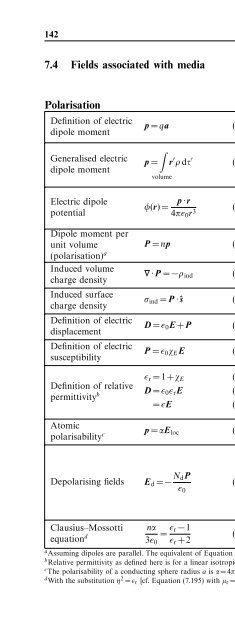Create successful ePaper yourself
Turn your PDF publications into a flip-book with our unique Google optimized e-Paper software.
142 Electromagnetism<br />
7.4 Fields associated with media<br />
Polarisation<br />
Definition <strong>of</strong> electric<br />
dipole moment<br />
Generalised electric<br />
dipole moment<br />
Electric dipole<br />
potential<br />
p = qa (7.80)<br />
∫<br />
p =<br />
volume<br />
r ′ ρ dτ ′ (7.81)<br />
φ(r)= p ·r<br />
4πɛ 0 r 3 (7.82)<br />
Dipole moment per<br />
unit volume<br />
(polarisation) a P = np (7.83)<br />
Induced volume<br />
charge density<br />
Induced surface<br />
charge density<br />
Definition <strong>of</strong> electric<br />
displacement<br />
Definition <strong>of</strong> electric<br />
susceptibility<br />
±q end charges<br />
a charge separation<br />
vector (from − to +)<br />
p dipole moment<br />
ρ charge density<br />
dτ ′ volume element<br />
r ′ vector to dτ ′<br />
φ<br />
r<br />
ɛ 0<br />
P<br />
n<br />
dipole potential<br />
vector from dipole<br />
permittivity <strong>of</strong> free<br />
space<br />
polarisation<br />
number <strong>of</strong> dipoles per<br />
unit volume<br />
∇·P = −ρ ind (7.84) ρ ind volume charge density<br />
σ ind = P ·ŝ (7.85)<br />
D = ɛ 0 E +P (7.86)<br />
σ ind<br />
ŝ<br />
D<br />
E<br />
surface charge density<br />
unit normal to surface<br />
electric displacement<br />
electric field<br />
P = ɛ 0 χ E E (7.87) χ E electrical susceptibility<br />
(may be a tensor)<br />
− p +<br />
✲<br />
ɛ r =1+χ E (7.88)<br />
Definition <strong>of</strong> relative<br />
permittivity b D = ɛ 0 ɛ r E (7.89)<br />
= ɛE (7.90)<br />
ɛ r<br />
ɛ<br />
relative permittivity<br />
permittivity<br />
Atomic<br />
polarisability c p = αE loc (7.91)<br />
Depolarising fields<br />
Clausius–Mossotti<br />
equation d<br />
E d = − N dP<br />
ɛ 0<br />
(7.92)<br />
nα<br />
= ɛ r −1<br />
3ɛ 0 ɛ r +2<br />
(7.93)<br />
α<br />
E loc<br />
E d<br />
N d<br />
polarisability<br />
local electric field<br />
depolarising field<br />
depolarising factor<br />
=1/3 (sphere)<br />
=1 (thin slab ⊥ to P)<br />
=0 (thin slab ‖ to P)<br />
=1/2 (long circular<br />
cylinder, axis ⊥ to P)<br />
a Assuming dipoles are parallel. <strong>The</strong> equivalent <strong>of</strong> Equation (7.112) holds for a hot gas <strong>of</strong> electric dipoles.<br />
b Relative permittivity as defined here is for a linear isotropic medium.<br />
c <strong>The</strong> polarisability <strong>of</strong> a conducting sphere radius a is α =4πɛ 0 a 3 . <strong>The</strong> definition p = αɛ 0 E loc is also used.<br />
d With the substitution η 2 = ɛ r [cf. Equation (7.195) with µ r = 1] this is also known as the “Lorentz–Lorenz formula.”


